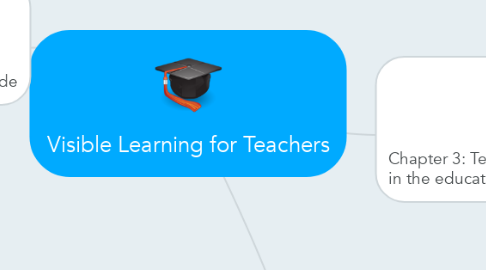
1. Chapter 1: Visible Learning Inside
1.1. Hattie suggests the bar should be set higher than 0.0
1.1.1. This is not a mathematically supported idea.
1.2. Effect Size: 0.4 set as the hinge-point
1.2.1. Anything higher than that is considered a medium or high impact. Lower than that is considered a low impact.
1.3. Critical Evaluation: Both teacher and administration need to be involved in critical evaluation to have the highest impact on student achievement.
1.4. Teachers need to have the mindset of an evaluator, change agent, critical planner, learning expert, and receiver of feedback.
2. Chapter 2: Source of the Ideas
2.1. Reaction to the initial book was missed. Hates argues that while some people perceived that it was a negative reaction to education. He disagreed. He describes his earlier work as positive and that it was shining a light on many of the great teachers in the world.
2.2. Meta-Analysis: A study of other scientific studies, journals, research, etc. Instead of creating his own original work, Hattie studied previous studies and tried to find common patterns by studying the data.
2.2.1. Over 900 studies were apart of Hattie's meta analysis.
2.3. Hattie points out that the study results are not intended to pass judgement on the past of education. Homework, for example, in Hattie's study was not found to be high on his scale. Hattie would say not that homework is useless but we need to change the way we give homework.
2.4. One of the most critical things a teacher can have is a mindset.
2.4.1. Reminded me very much of the Growth Mindset theory put forward by Carol Dweck.
2.5. Hattie describes each influence as having a low, medium or high impact.
3. Chapter 3: Teachers; the major players in the education process
3.1. Teachers are the most important influence in a classroom, not the students.
3.1.1. Not all teachers are great teachers.
3.1.2. There are strategies that can be used to improve teaching.
3.2. Teachers must be inspired and passionate
3.2.1. There are 5 dimensions of inspired and passionate teachers are.
3.2.1.1. Teachers can identify the most important ways in which to represent the numbers they teach.
3.2.1.2. Teachers are proficient at creating classroom environment
3.2.1.2.1. It's okay to make mistakes! In fact, it's encouraged.
3.2.1.3. Teachers monitor learning and provide feedback
3.2.1.4. Teachers believe all students can reach success criteria.
3.2.1.4.1. Any student can be successful and teachers must hold high beliefs and high standards for all students.
3.2.1.5. Teachers influence surface and deep student outcomes.
3.3. Hattie argues that the intention of the book is not to promote measuring teachers by using his criteria, but influencing how teachers teach.
3.3.1. Influencing student minds in the point of the lesson according to Hattie.

